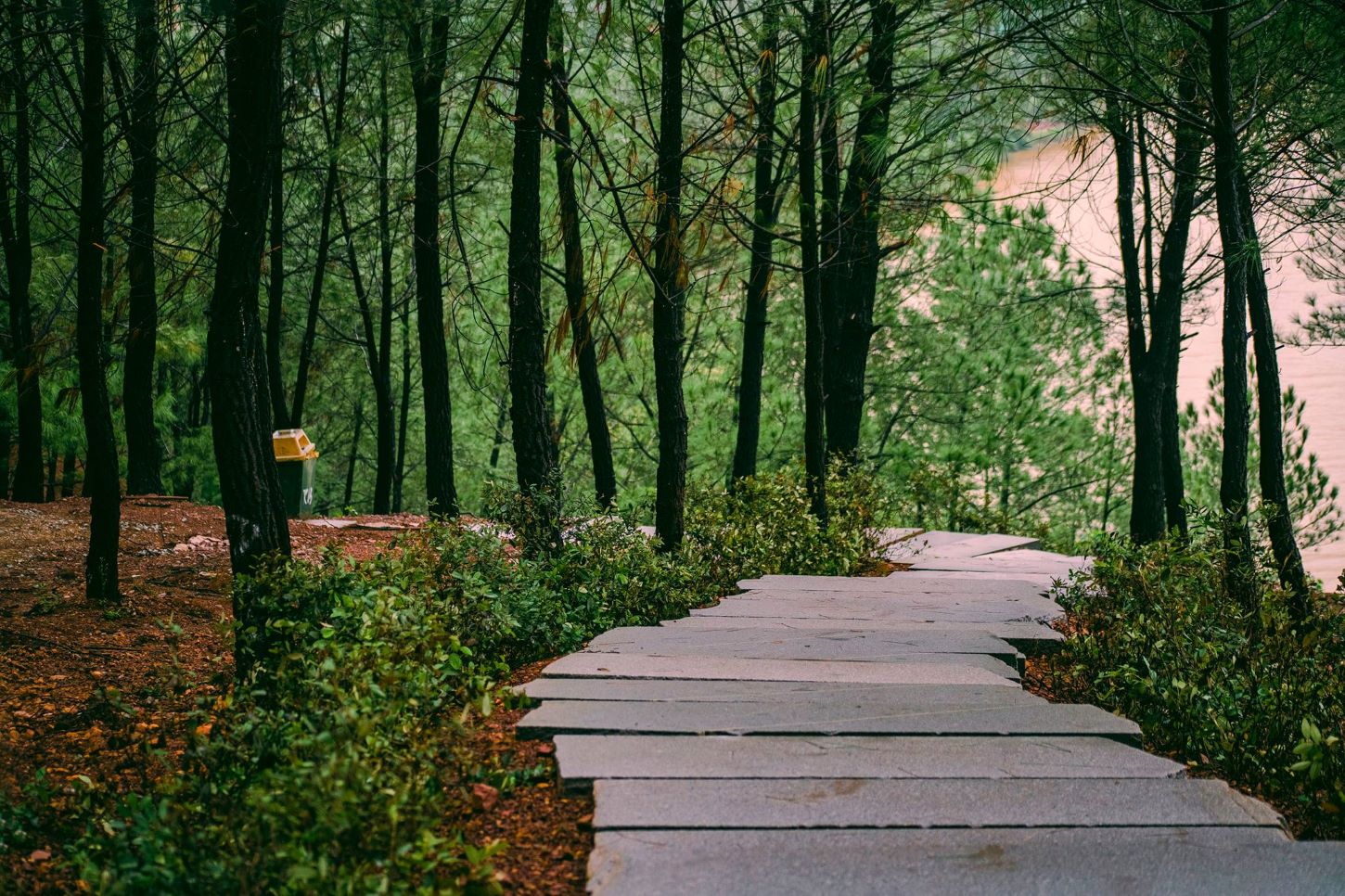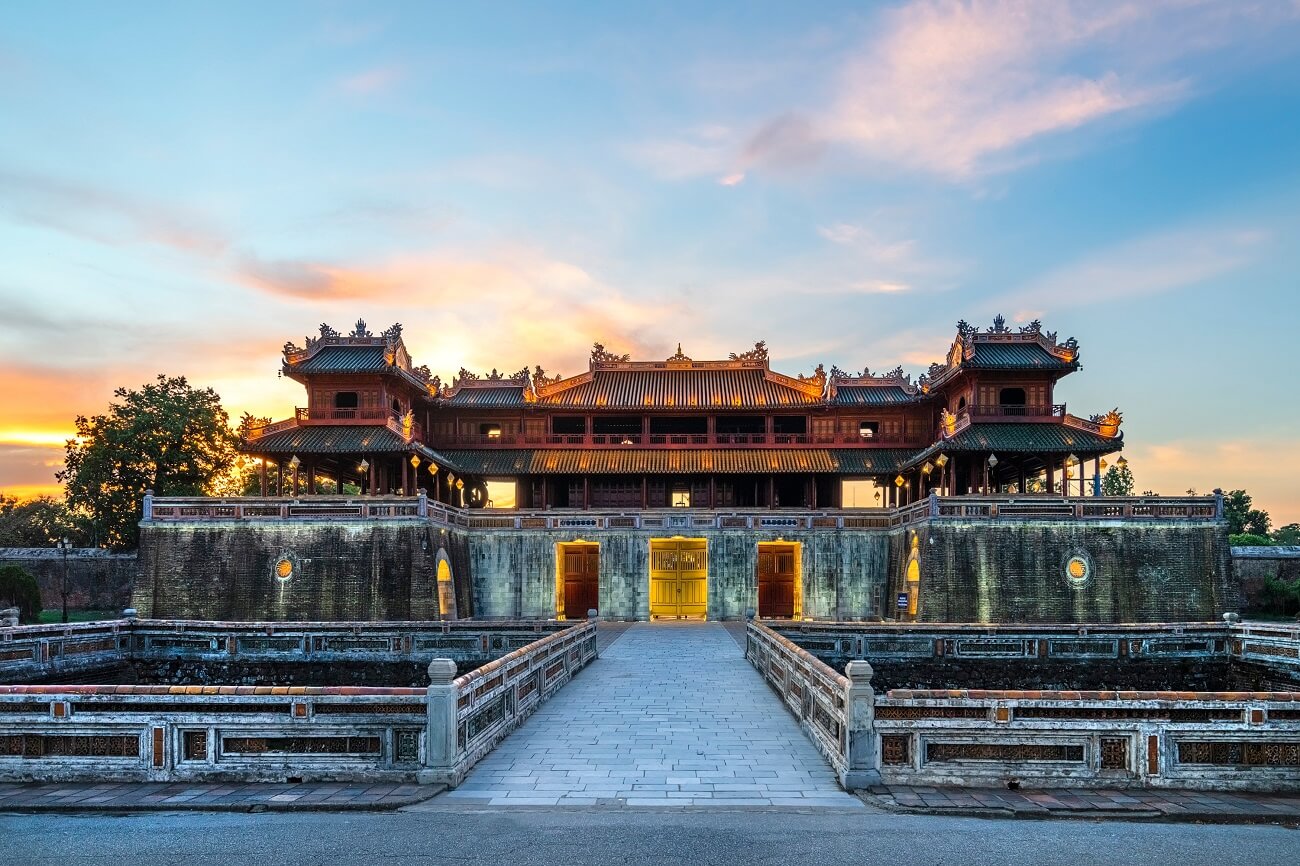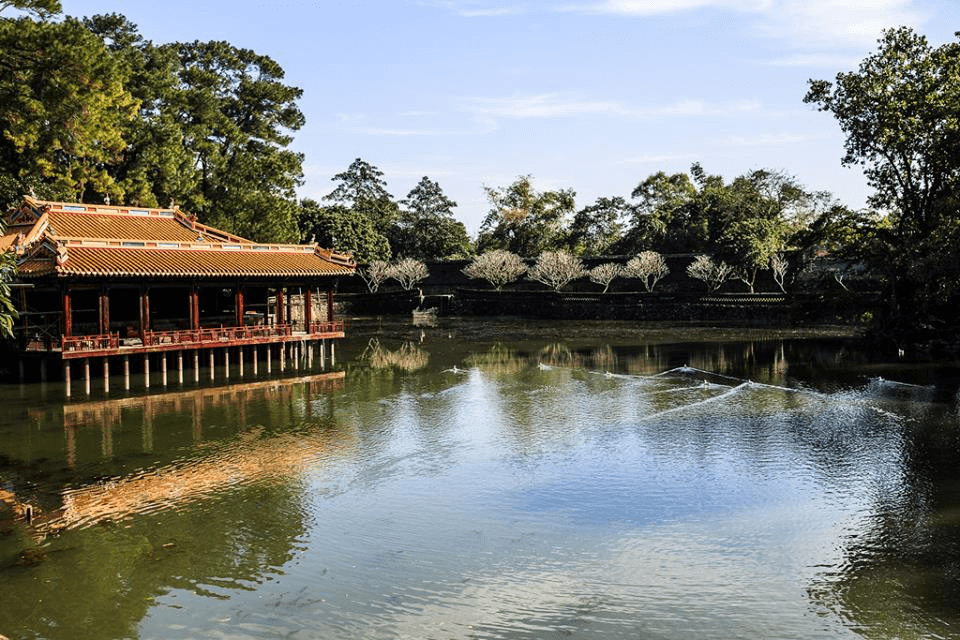Ngọ Môn Gate – a majestic symbol and the soul of the ancient capital of Hue, awaits your discovery. Not only is it a magnificent gateway to the Imperial City, but it is also a silent witness to many historical ups and downs, hiding countless architectural secrets and fascinating cultural stories. Join Queen Cafe Open Bus to open the door of time, stroll through Ngọ Môn Gate in Hue, and feel the depth of beauty, where the past and present blend together in a magical way.
1. Overview of Ngọ Môn Gate in Hue
1.1. Where is the Ngọ Môn Gate?
1.1.1. The exact location of Ngộ Môn Gate in Hue
Are you wondering where Ngọ Môn Gate is? Just imagine it: Ngọ Môn Gate stands majestically right in the center, as the southern gate of the Imperial City of Hue. It is located entirely within the Hue Monuments Complex, recognized by UNESCO, and sits peacefully on 23 Tháng 8 Street, Phú Hậu Ward, Hue City.
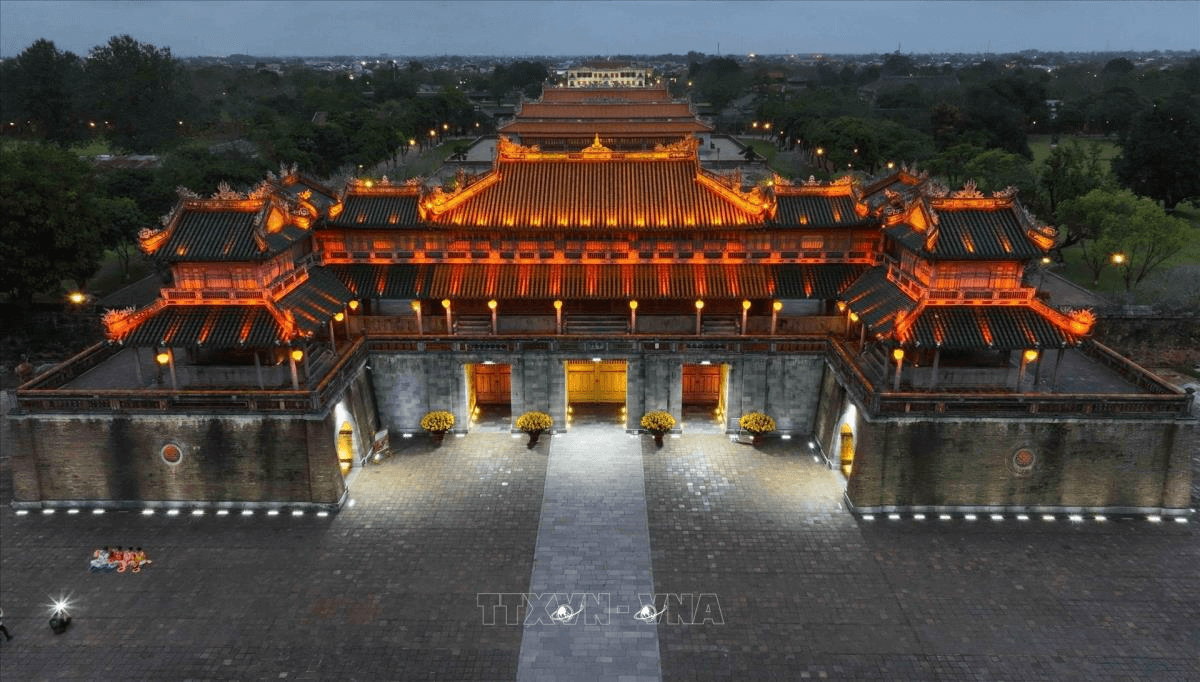
1.1.2. The Role of Ngọ Môn Gate in the Imperial City of Hue
With such a prime location, the main gate of Ngo Mon became the most important entrance, leading straight to Thai Hoa Palace, where the most solemn and dignified court sessions and ceremonies of the ancient Nguyen dynasty took place. This is the starting point for a journey back in time to discover the hidden beauty within. The Imperial City of Hue.
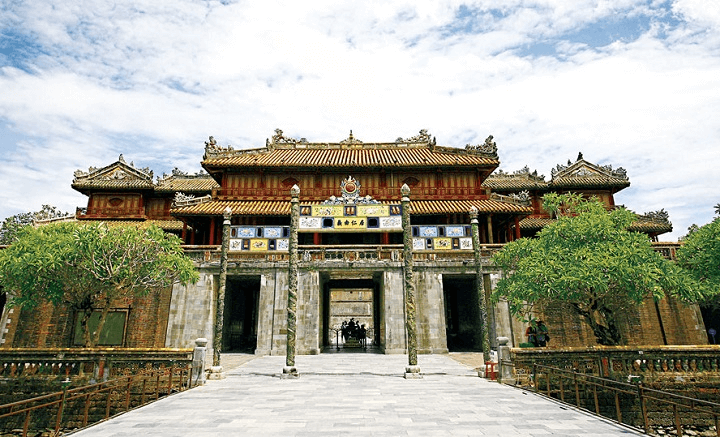
1.2. Decoding the meaning of the name "Ngọ Môn"
When you hear the name "Ngọ Môn," have you ever wondered if "Ngọ" here refers to the Ngọ hour (midday)? That's a pretty common misunderstanding!
Actually, according to ancient Eastern feng shui knowledge, "Ngọ" does not only refer to time but also indicates the south direction on the Tý – Ngọ (North – South) axis. The Ngọ Môn Gate was built facing south, the direction of development, vitality, and supreme authority. For this reason, the name Ngọ Môn was born, imbued with profound geographical and cultural significance for the Nguyễn dynasty.
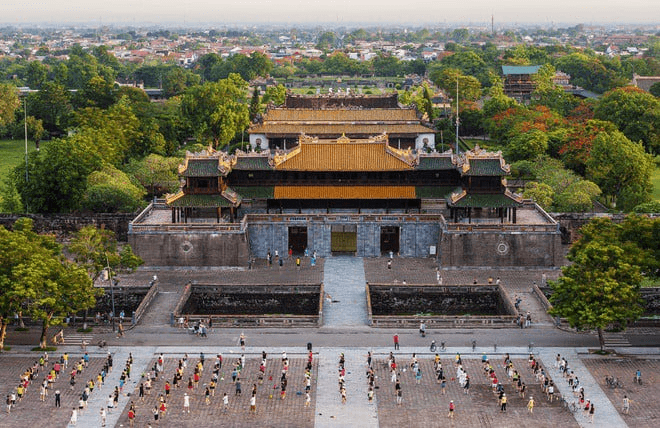
1.3. Latest opening hours and admission fees for Ngọ Môn Gate
For the tour tourist destination Hue This is really convenient, so be sure to "pocket" this useful information about opening hours and admission tickets:
Opening hours:
- Daytime: from 05:00 AM to 5:00 PM, so you can explore freely under the sun.
- Evening (night tour of the Imperial City): from 7:00 PM to 10:00 PM, experience the enchanting beauty of the palace at night.
Ticket price:
- Adults: 150,000 VND per person
- Children (ages 7-12): 30,000 VND per person
- Children under 6 years old: Completely free
A little tip: If you visit Hue during special occasions such as Lunar New Year, Hue Liberation Day (March 29), or National Day (September 2), you will be granted free admission to enjoy the beauty of the Ngo Mon Gate. The Imperial City of Hue and the entire historical site, okay?
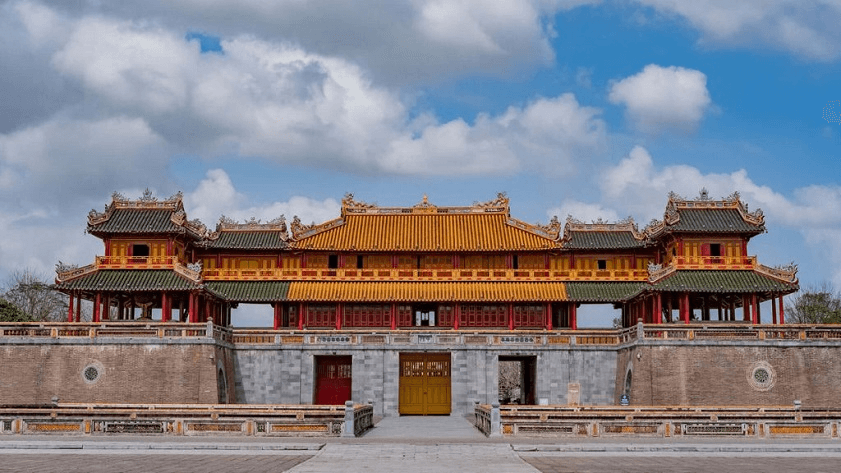
2. Directions to the Main Gate of Ngo Mon
2.1. Easy access to Hue by high-quality sleeper bus
If you want to experience the beautiful scenery on the way to Hue, Queen Cafe Bus with its modern, comfortable limousine and private cabins is the right choice.
Queen Cafe Bus will take you directly to the center of Hue at 7 Doi Cung, very close to Trang Tien BridgeHere, you can easily check into your hotel and get ready to explore Ngọ Môn Gate and the Imperial City. Below is a reference price list for Queen Cafe Bus routes so you can plan ahead and budget accordingly:
| BUS ROUTE TO HUẾ | PRICE | BOOK TICKETS |
| Hanoi ⇔ Hue | $15.00 – $22.50 | Place it here |
| Da Nang ⇔ Hue | $150 | Place it here |
| Hoi An ⇔ Hue | $150 | Place it here |
| Ninh Binh ⇔ Hue | $150 - $200 | Place it here |
| Quang Binh ⇔ Hue | $180 | Place it here |
📞 For attentive consultation and the fastest ticket booking, you can contact:
- Hotline: 0906.413.468 – 0914.215.809
- Zalo: 0905.746.884 – 0914.215.809
- Website: https://queenbus.com.vn/
- Fanpage: Queen Cafe Open Bus
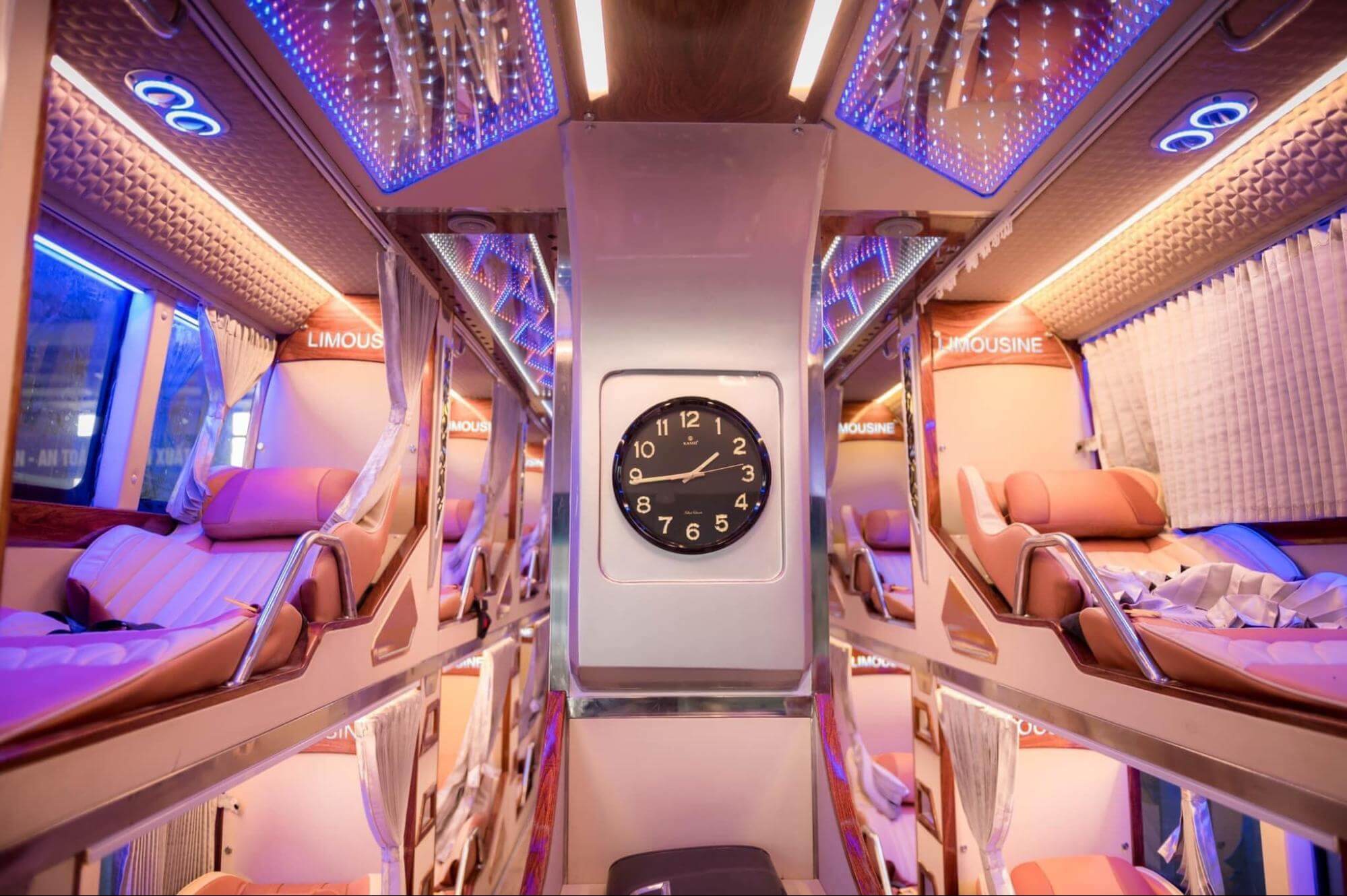
2.2. Transportation from Hue City to Ngo Mon Gate
Once you arrive at the bus station in Hue, getting to the main gate of Ngo Mon will be very flexible with many interesting means of transportation:
- Cycle rickshaw: This is a very Hue experience that you should try! Slowly pedaling on a cyclo, you will be able to leisurely admire the sights. Perfume River romantic, ancient streets and breathe in the fresh air of the ancient capital on the way to the Imperial Citadel.
- Motorcycle: For young souls who love to explore and want the freedom to visit more places in Hue.
- Taxi/Ride-hailing: Fast, convenient, especially suitable for groups of friends or large families, helping you get there quickly.
3. Discover the architectural masterpiece of Ngọ Môn Gate in the Imperial City of Hue
3.1. Overall Structure of Ngọ Môn Gate
The Ngo Mon Gate is a complex structure, where the solidity of the base below and the elegance of the Five Phoenix Pavilion above blend together in a magical way. Despite the different materials and properties—solid brick and light wood—the overall effect creates a balance and a harmonious beauty that is astonishing.

3.2. Details of the lower level of Ngọ Môn Gate: U-shaped platform system and 5 walkways
Descending to the lower level, you will see another part that contributes to the solidity of the Ngo Mon Gate – the massive foundation system, built with distinct meanings that clearly reflect the feudal hierarchy.
3.2.1. The Scale of Ngọ Môn Gate in Hue
The base of the Ngo Mon Gate is impressive in scale, built in a right-angled U-shape, nearly 5 meters high. To create a structure that would stand the test of time, the ancients used brick and stone combined with brass load-bearing beams. This sturdy material not only ensured the durability of the structure but also symbolized the stability and longevity of the dynasty.
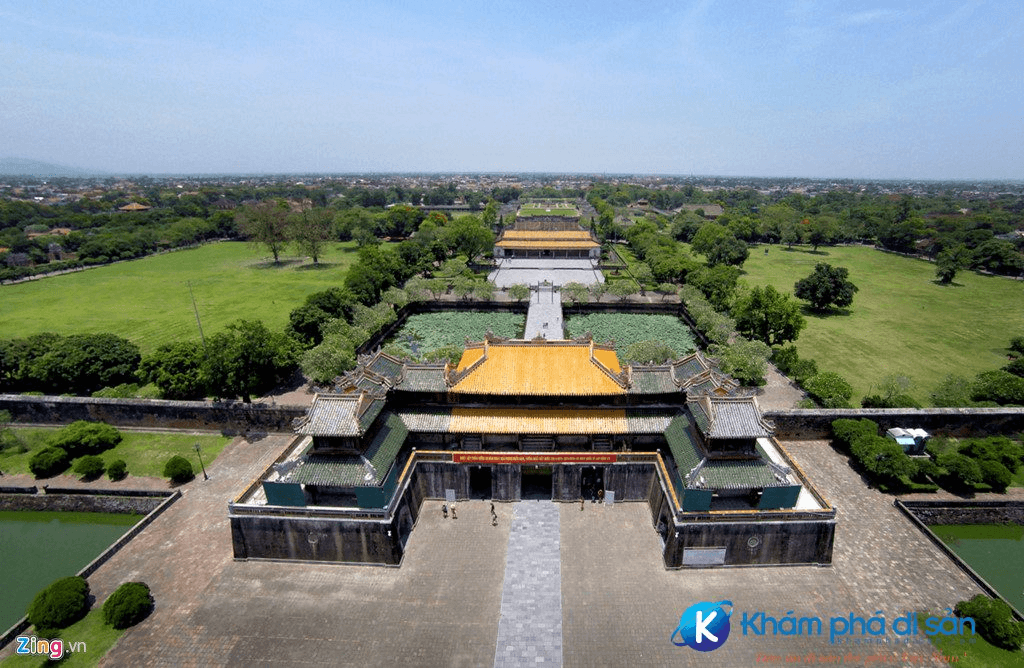
3.2.2. Ngọ Môn (Middle Gate)
Located right in the center of the platform, the No Mon Gate (also known as No Mon Quan) is the largest and most important passageway. This is the only path reserved exclusively for the Emperor – the symbol of supreme authority and the unique position of the Son of Heaven. This passageway is usually only opened on major ceremonial occasions, reflecting the solemnity and sacredness of the reigning monarch.

3.2.3. Left Gate and Right Gate
The two doors on either side of the Ngọ Môn are the Left Wing Gate and the Right Wing Gate. These are formal entrances reserved exclusively for civil officials (through the Left Wing Gate) and military officials (through the Right Wing Gate) in the royal procession when they accompany the emperor to court. This division clearly reflects the hierarchy and positions within the imperial court.
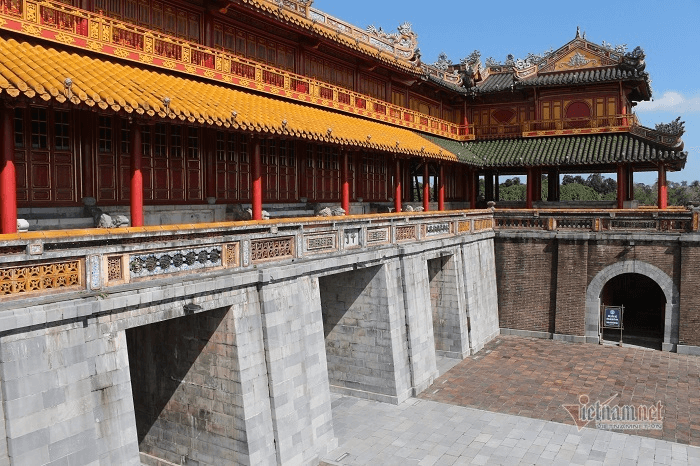
3.2.4. Left Gate and Right Gate
Finally, the two side entrances located at the outer edges, symmetrical across the main axis, are the Left Service Gate and the Right Service Gate. These gates were used by soldiers, elephants and horses in attendance, or those without high rank. The division of the entrances was not only a regulation but also part of the ritual, reflecting the clear hierarchy in feudal society and the strict order within the imperial court.


3.3. Details of the upper level of the Ngọ Môn Gate: The magnificent beauty of the Ngũ Phụng Pavilion
Ascending to the upper floor, you will be overwhelmed by the magnificent beauty of the Five Phoenix Pavilion—a true masterpiece where architectural beauty is elevated to profound symbolic meaning.
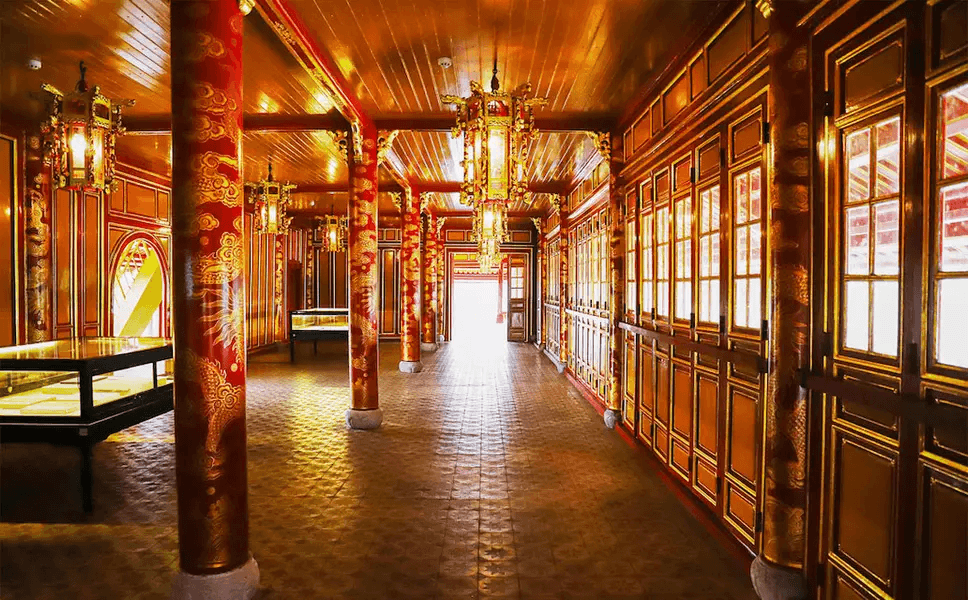
3.3.1. The structure of 100 teak columns of Ngọ Môn Gate in Hue
The Ngũ Phụng Pavilion is supported by a system of 100 sturdy teak columns. The number 100 is not merely a quantity, but also carries profound symbolic meaning: it represents the strength of a hundred families united in harmony, the balance of yin and yang, and the integrity and stability of the nation. Teak wood, a rare and durable wood, also symbolizes the longevity of the dynasty.
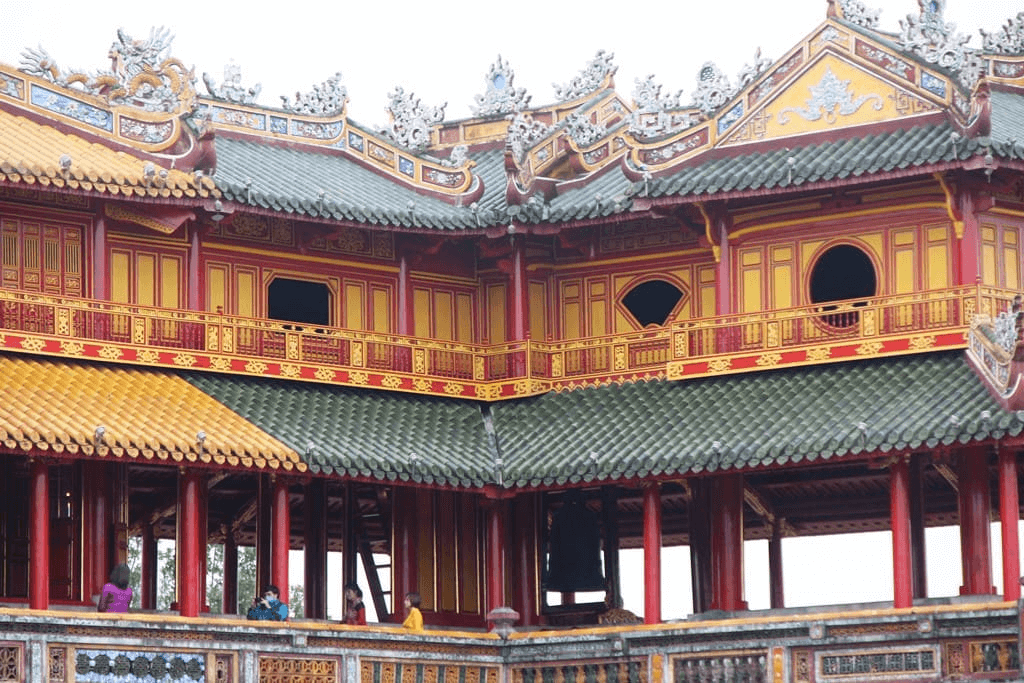
3.3.2. The system of nine Lưu Ly tile roofs of the Ngọ Môn Gate
This is the most unique feature, creating the distinctive beauty of the Five Phoenix Tower and also the origin of its beautiful name. The tower has nine layers of glazed tile roofs – a number that carries many auspicious meanings in Eastern culture (nine heavens).
The highest central roof section, distinguished by its brilliant yellow color, is reserved exclusively for the Emperor. The remaining eight roof sections are covered with blue glazed tiles, symbolizing the solemnity of the imperial court and the beauty of heaven and earth. From afar, the nine curved roof sections resemble five phoenixes spreading their wings, perched atop the gate, creating an image that is both majestic and graceful, full of artistic beauty.

3.3.3. The Exquisite Decorative Details of the Ngo Mon Gate
Don't forget to take time to admire the windows in various shapes: round, fan-shaped, and square, each carrying auspicious meanings and high aesthetic value. Along with countless exquisite decorative patterns on the roof ridges, eaves, dragon and phoenix motifs... Each small detail is a testament to the talent, creativity, and dedication of the ancient court artisans, transforming the Ngo Mon Gate into a living architectural museum.

4. Golden historical imprints at Ngo Mon Gate
The Ngọ Môn Gate is not only a beautiful architectural structure, but also a living history book, witnessing the ups and downs and major events of the Nguyễn dynasty and the entire nation.
4.1. The Construction History of Ngọ Môn Gate
Before the majestic Ngọ Môn Gate as we know it today, this location was once Nam Khuyết Đài – part of the Imperial City of Huế built during the Gia Long era. It was not until the 14th year of the Minh Mang reign (1833) that the court decided to undertake a major architectural overhaul of the Imperial City. To build a capital worthy of the dynasty, Nam Khuyet Dai was demolished and the magnificent Ngo Mon Gate was commenced. This project stands as a testament to the pinnacle of architectural and urban planning achievements during the Nguyen dynasty.

4.2. Ngo Mon Gate – Where the most important ceremonies of the Nguyen dynasty took place
Throughout the Nguyen dynasty, Ngo Mon Gate was the center of many important ceremonies, symbolizing the authority and dignity of the royal court, and attracting the attention of all subjects.
- Military Parade: Grand military parades, showcasing the nation's military strength, often take place right in the square in front of the Ngo Mon Gate, attracting large crowds.
- Doctorate Announcement Ceremony: This is the ceremony to announce the names of newly graduated doctors after each court examination, honoring outstanding talents who have contributed their intellect to the country. The echo of the announcement from the Ngũ Phụng Tower reverberating throughout the capital is a source of pride for an entire generation.
- The Ban Sóc Ceremony: A ceremony to distribute the new calendar to the entire country at the beginning of the year. From the Ngũ Phụng Tower, the king would distribute the calendar to officials, who would then distribute it throughout the provinces, demonstrating the king's role in harmonizing yin and yang, bringing peace and good fortune to the people, and symbolizing national unity.

4.3. Ngo Mon Gate – Witness to a momentous historical occasion
One of the most unforgettable historical events, deeply associated with the Ngọ Môn Gate, took place on the afternoon of August 30, 1945. It was on the balcony of the Ngũ Phụng Pavilion that Emperor Bảo Đại, the last emperor of the Vietnamese feudal regime, read his abdication decree, officially ending an era of monarchy. This marked a monumental turning point, opening a new chapter in history filled with upheaval yet brimming with hope for the Vietnamese people. The Ngọ Môn Gate witnessed that momentous historical event, a symbol of transformation.
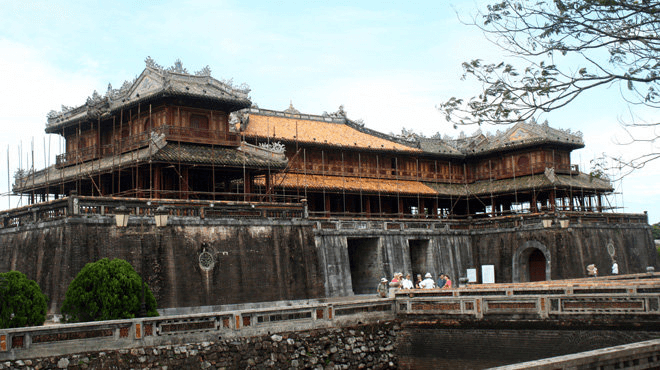
4.4. The journey of restoration and preservation of the Ngọ Môn Gate heritage over the years
Having weathered the vicissitudes of time and history, Ngọ Môn Gate has undergone numerous restorations to preserve its beauty and value. The structure was restored during the reigns of Emperor Thành Thái and Emperor Khải Định. Notably, following the 1968 Tet Offensive, Ngọ Môn Gate sustained significant damage due to the war.
A major restoration project was carried out from 2012 to 2019, with the meticulous and dedicated work of experts, helping to restore the original beauty and grandeur of this unique architectural structure. As a result, visitors today can still fully appreciate the magnificent and splendid image of the Ngọ Môn Gate as it was in the past, gaining a deeper understanding of the historical value it embodies.
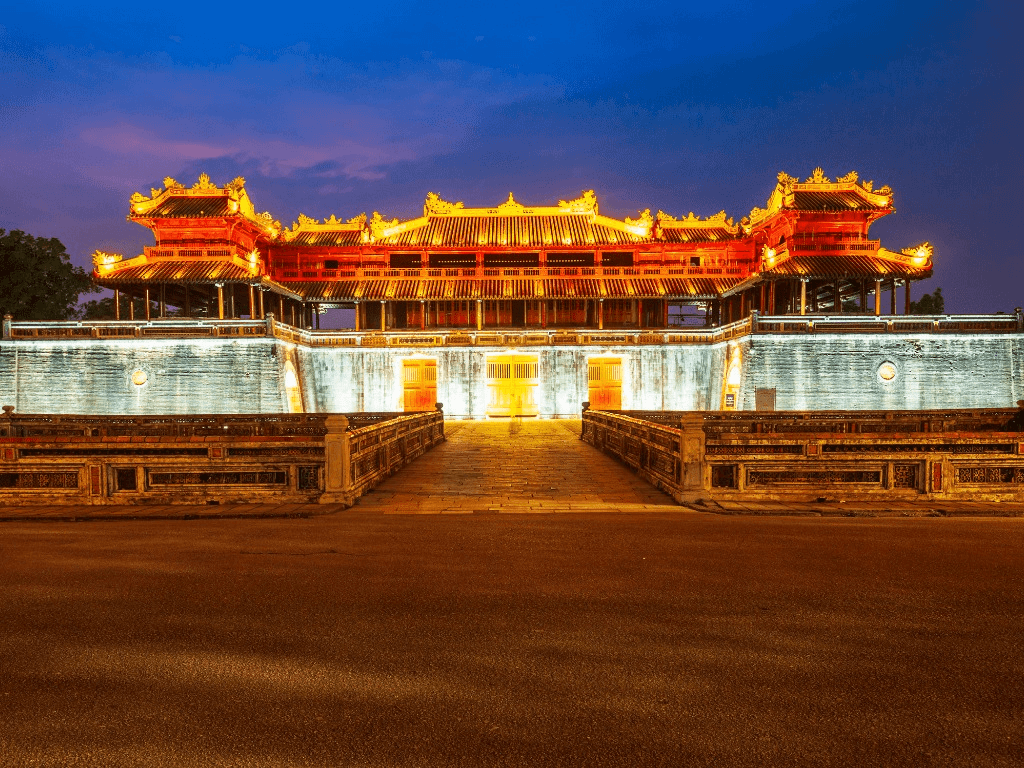
5. Experience visiting and checking in with photos of the Ngọ Môn Gate
To create beautiful memories, profound experiences, and stunning photos of the Ngọ Môn Gate that will captivate thousands, here are a few tips to keep in mind!
5.1. The best time to visit Ngộ Môn Gate
To make your trip truly complete, you should visit Ngọ Môn Gate at the following times:
- Spring (January-March): The weather is cool and pleasant, the scenery is lush and green, making it ideal for strolling, sightseeing, and taking photos without worrying about the sun or rain.
- Hue Festival Season (April-May): If you love the festive atmosphere, this is when the ancient capital is at its most vibrant with spectacular artistic performances, especially in the evening when the Ngo Mon Gate glows under the lights.

5.2. Tips for taking "virtual" photos at Hue's Ngọ Môn Gate that everyone loves
The Ngọ Môn Gate, with its magnificent ancient architecture, is the perfect backdrop for those "million-like" photos. To take stunning "Instagram-worthy" photos at the Ngọ Môn Gate, keep these tips in mind:
- Attire: Opt for traditional ao dai or ao nhat binh to blend into the ancient atmosphere. Red, gold, or dark-colored outfits will also help you stand out.
- Accessories: Add a charming conical hat or paper fan to create a Vietnamese cultural accent.
- Shooting angle:
- Take wide-angle shots from a distance to capture the magnificent panorama of the structure.
- Close-up shots of the intricate details on the Five Phoenix Pavilion or the platform base.
- Try taking a photo from inside the Five Phoenix Tower looking out to capture the romantic scenery of the ancient capital.

- Time: Wait for dawn or dusk to capture the soft orange-yellow light, creating a sparkling effect for the photo.
5.3. Important rules to remember when visiting Ngọ Môn Gate
To preserve this precious heritage and have a truly enjoyable and meaningful trip, please always remember the following small rules:
- Always keep your ticket handy for easy access when moving between areas within the Imperial City.
- Dress modestly and respectfully when visiting, especially in religious areas (avoid sleeveless tops, shorts/skirts that are too short) to show respect for historical and cultural values.
- Do not film or take photos with flash inside the interiors of worship areas to protect the artifacts and avoid disturbing others.
- Maintain public hygiene, do not write or draw on structures, and do not litter indiscriminately to help protect our heritage.
- Take good care of your personal belongings, especially during the busy tourist season, to avoid unwanted incidents.

6. Final words
Ngọ Môn Gate is not just an architectural structure, but the soul of the ancient capital of Hue. Each brick tells a story of a golden dynasty and enduring cultural values. When you come here, you will not only visit, but also deeply feel the breath of history and eternal beauty.
What are you waiting for? Let Queen Cafe Bus take you to Hue. Book your Queen Cafe Bus sleeper bus ticket today and get ready to admire the magnificent and meaningful beauty of Hue's Ngo Mon Gate.


